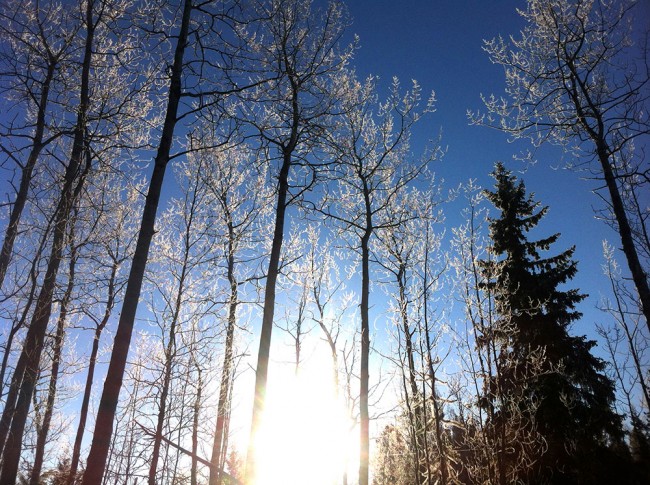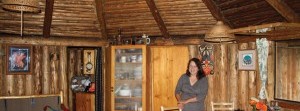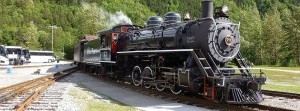
Photo Credit: Matt J. Simmons
Oh, Christmas Tree!
“This year, we will find the perfect tree!” Speaking these words with conviction, gusto and confidence is usually how the annual pilgrimage to the backroads starts out.
The day is crisp and blue, sharp snow crystals twinkle in the sun, and everyone is high on the anticipation of the hunt. Coffee and hot chocolate are sealed into thermoses and packed into a packsack with the Christmas cookies and sandwiches. Scarves tied around necks, sharp saw in hand, all members of the family jauntily forge through the knee-deep snow singing “O Christmas Tree.”
A more Norman Rockwell moment has never been painted—and maybe that’s why art is so healing. I’ve never seen a painting of the family that forgot the saw in the car after walking 45 minutes into the bush or the crying child with one lost mitten or the moment in the rapidly deepening dusk when the weird-looking hemlock is declared “almost as good as that last one back there” and hastily sawn down before everyone totally loses all composure.
We’ve all been there. After the tree is in the house, the kids are warming up in the bathtub and we’ve mopped all the puddles off the floor, we stand back with a slightly puzzled expression thinking, “Wow, it looked so much fuller in the forest—where did all the branches go from that one side?”
Finding a Christmas tree can be fun, but also frustrating if you are unprepared or your expectations are too high. Whether artificial or farmed, finding the perfect tree is more about finding inner peace with your tolerance for the process than finding fullness and symmetry.
Fake versus real
When it comes to real versus artificial trees, people usually fall clearly in one camp. Team Real would expound on the virtues of the fresh scent and the feel of the needles, recount happy memories of childhood excursions and rely heavily on the value of tradition. Team Fake points to the practical conveniences of no dropped needles, no watering and that whole bonus afternoon you get when all you have to do is unzip the giant bag and straighten out a few branches.
Both sides will probably claim their choice to be the best for the environment. Natural trees sequester carbon and produce oxygen, which is important for fighting climate change and providing the air we breathe; artificial trees are reusable and do not require fertilizers or pesticides, which inevitably end up in our drinking water. There are a myriad of variables to consider: material sourcing, pollution related to either manufacturing and shipping (fake), or growing and transporting (real) and, for all trees, the environmental impact of disposal.
Real v. Fake Christmas trees has become such a hotly debated issue that Ellipsos, a research firm based in Montreal, completed a “Comparative Life Cycle Assessment” to determine the answer. The study concludes that a farmed tree is lower impact than an artificial tree if the consumer drives five km or fewer to purchase it. If an artificial tree is kept for more than 20 years, it starts to become competitive. Trees growing naturally in the forest were not included in the study, but it is likely they would come out on top provided that you did not drive very far to cut one down. That said, the report states:
The emitted CO2 over the entire lifecycle are 3.1 kg CO2 for the natural tree and 8 kg C02 per year for the artificial tree. These C02 emissions roughly correspond to driving an average car (150 g/km) 125 and 322 km respectively. Therefore carpooling or biking to work only one to three weeks per year would offset the carbon emissions from both types of Christmas trees.
Thereby demonstrating that there are bigger environmental problems to worry about than the contribution of Christmas trees to global pollution or climate change.
Farmed versus foraged
If you decide to stick with Team Real, you have to choose if you want the adventure of cutting your own or if you want to support the local Christmas tree supplier or figure skating club and pick one up out of the back of a refrigerated truck.
Farmed trees are specifically pruned to be full and lush and perfectly shaped, so you won’t have to worry about turning that bare patch to the wall. Select a tree that looks healthy, as one with many brown needles will not last long. Since farmed trees are already stressed from being shipped and won’t last as long as freshly cut, purchase it a couple weeks before Christmas. Some growers allow customers to select and cut their own tree, offering the guarantee of a well-shaped tree with the fun of cutting it down yourself.
Heading out into the wilds (or the side of the road or BC Hydro right-of-way) is another option. Before harvesting a tree on Crown land, make sure to obtain a Free Use Permit. This can be done online (in some areas) and free of charge, if you are at least 19 years old and a resident of British Columbia. Each forest district has specific permit conditions that can be found at www.for.gov.bc.ca/mof/xmastrees.htm. Do not cut a tree from private land, plantations, research areas, parks, watersheds, areas where trees have been deliberately spaced or any other areas reserved for a special use.
Beyond the legalities, being prepared will help make the experience enjoyable. Bring tools including a sharp saw, pruners or a small hatchet and rope. Dress for the weather and bring food and a hot drink in case finding the “perfect” tree takes longer than you think. Logging trucks are active in many areas; bring a radio and drive with caution. When you have found the tree you like, cut it as close to the ground as possible and leave the stump flat rather than sharply angled to reduce fire hazards and risks to wildlife or other users.
Though a popular farmed tree choice, Douglas fir does not grow everywhere and you will probably need to be open to other species. Without breaking down the pros and cons of each species, it is helpful to know that balsam fir tends to produce pitch, so the area under the tree should be covered to protect flooring, and spruce trees have very sharp needles which may be a good choice for owners of curious cats.
Care and keeping
When your newly purchased or foraged tree is home, cut an inch off the bottom. This will help it access water more easily and make it last longer. A newly set up tree will initially suck up a lot of water so check it frequently for the first couple days. Set it up away from heat sources or fans so it does not dry out.
When, finally, the music is on and the decorations are being hung, it feels like Christmas and it doesn’t matter if the tree is real, fake or perfect. It is the thought that counts, right?




